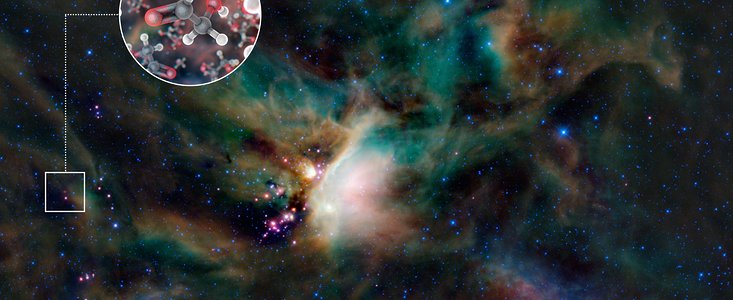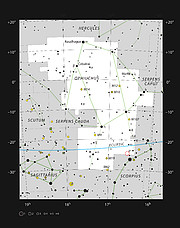Press Release
Sweet Result from ALMA
Building blocks of life found around young star
29 August 2012
A team of astronomers using the Atacama Large Millimeter/submillimeter Array (ALMA) has spotted sugar molecules in the gas surrounding a young Sun-like star. This is the first time sugar been found in space around such a star, and the discovery shows that the building blocks of life are in the right place, at the right time, to be included in planets forming around the star.
The astronomers found molecules of glycolaldehyde — a simple form of sugar [1] — in the gas surrounding a young binary star, with similar mass to the Sun, called IRAS 16293-2422. Glycolaldehyde has been seen in interstellar space before [2], but this is the first time it has been found so near to a Sun-like star, at distances comparable to the distance of Uranus from the Sun in the Solar System. This discovery shows that some of the chemical compounds needed for life existed in this system at the time of planet formation [3].
“In the disc of gas and dust surrounding this newly formed star, we found glycolaldehyde, which is a simple form of sugar, not much different to the sugar we put in coffee,” explains Jes Jørgensen (Niels Bohr Institute, Denmark), the lead author of the paper. “This molecule is one of the ingredients in the formation of RNA, which — like DNA, to which it is related — is one of the building blocks of life.”
The high sensitivity of ALMA — even at the technically challenging shortest wavelengths at which it operates — was critical for these observations, which were made with a partial array of antennas during the observatory’s Science Verification phase [4].
“What it is really exciting about our findings is that the ALMA observations reveal that the sugar molecules are falling in towards one of the stars of the system,” says team member Cécile Favre (Aarhus University, Denmark). “The sugar molecules are not only in the right place to find their way onto a planet, but they are also going in the right direction.”
The gas and dust clouds that collapse to form new stars are extremely cold [5] and many gases solidify as ice on the particles of dust where they then bond together and form more complex molecules. But once a star has been formed in the middle of a rotating cloud of gas and dust, it heats the inner parts of the cloud to around room temperature, evaporating the chemically complex molecules, and forming gases that emit their characteristic radiation as radio waves that can be mapped using powerful radio telescopes such as ALMA.
IRAS 16293-2422 is located around 400 light-years away, comparatively close to Earth, which makes it an excellent target for astronomers studying the molecules and chemistry around young stars. By harnessing the power of a new generation of telescopes such as ALMA, astronomers now have the opportunity to study fine details within the gas and dust clouds that are forming planetary systems.
"A big question is: how complex can these molecules become before they are incorporated into new planets? This could tell us something about how life might arise elsewhere, and ALMA observations are going to be vital to unravel this mystery,” concludes Jes Jørgensen.
The work is described in a paper to appear in the journal Astrophysical Journal Letters.
The Atacama Large Millimeter/submillimeter Array (ALMA), an international astronomy facility, is a partnership of Europe, North America and East Asia in cooperation with the Republic of Chile. ALMA is funded in Europe by the European Southern Observatory (ESO), in North America by the U.S. National Science Foundation (NSF) in cooperation with the National Research Council of Canada (NRC) and the National Science Council of Taiwan (NSC) and in East Asia by the National Institutes of Natural Sciences (NINS) of Japan in cooperation with the Academia Sinica (AS) in Taiwan. ALMA construction and operations are led on behalf of Europe by ESO, on behalf of North America by the National Radio Astronomy Observatory (NRAO), which is managed by Associated Universities, Inc. (AUI) and on behalf of East Asia by the National Astronomical Observatory of Japan (NAOJ). The Joint ALMA Observatory (JAO) provides the unified leadership and management of the construction, commissioning and operation of ALMA.
Notes
[1] Sugar is the common name for a range of small carbohydrates (molecules containing carbon, hydrogen and oxygen, typically with a hydrogen:oxygen atomic ratio of 2:1, as in water). Glycolaldehyde has the chemical formula C2H4O2. The sugar commonly used in food and drink is sucrose, which is a larger molecule than glycolaldehyde, and another example of this set of compounds.
[2] Glycolaldehyde has been detected in two places in space so far — first towards the Galactic Centre cloud Sgr B2, using the National Science Foundation's (NSF) 12 Meter Telescope at Kitt Peak (USA) in 2000, and with the NSF's Robert C. Byrd Green Bank Telescope (also USA) in 2004, and in the high-mass hot molecular core G31.41+0.31 using the IRAM Plateau de Bure Interferometer (France) in 2008.
[3] Accurate laboratory measurements of the characteristic wavelengths of radio waves emitted by glycolaldehyde were critical for the team’s identification of the molecule in space. In addition to the glycolaldehyde, IRAS 16293-2422 is also known to harbour a number of other complex organic molecules, including ethylene glycol, methyl formate and ethanol.
[4] Early scientific observations with a partial array of antennas began in 2011 (see eso1137). Both before and after this, a range of Science Verification observations have been performed to demonstrate that ALMA is capable of producing data of the required quality, and the data produced have been made publicly available. The results described here use some of these Science Verification data. Construction of ALMA will be completed in 2013, when 66 high-precision antennas will be fully operational.
[5] They are usually around 10 degrees above absolute zero: about –263 degrees Celsius.
More information
This research was presented in a paper “Detection of the simplest sugar, glycolaldehyde, in a solar-type protostar with ALMA”, by Jørgensen et al., to appear in Astrophysical Journal Letters.
The team is composed of Jes K. Jørgensen (University of Copenhagen, Denmark), Cécile Favre (Aarhus University, Denmark), Suzanne E. Bisschop (University of Copenhagen), Tyler L. Bourke (Harvard-Smithsonian Center for Astrophysics, Cambridge, USA), Ewine F. van Dishoeck (Leiden Observatory, The Netherlands; Max-Planck-Institut für extraterrestrische Physik, Garching, Germany) and Markus Schmalzl (Leiden Observatory).
The year 2012 marks the 50th anniversary of the founding of the European Southern Observatory (ESO). ESO is the foremost intergovernmental astronomy organisation in Europe and the world’s most productive ground-based astronomical observatory by far. It is supported by 15 countries: Austria, Belgium, Brazil, Czechia, Denmark, France, Finland, Germany, Italy, the Netherlands, Portugal, Spain, Sweden, Switzerland and the United Kingdom. ESO carries out an ambitious programme focused on the design, construction and operation of powerful ground-based observing facilities enabling astronomers to make important scientific discoveries. ESO also plays a leading role in promoting and organising cooperation in astronomical research. ESO operates three unique world-class observing sites in Chile: La Silla, Paranal and Chajnantor. At Paranal, ESO operates the Very Large Telescope, the world’s most advanced visible-light astronomical observatory and two survey telescopes. VISTA works in the infrared and is the world’s largest survey telescope and the VLT Survey Telescope is the largest telescope designed to exclusively survey the skies in visible light. ESO is the European partner of a revolutionary astronomical telescope ALMA, the largest astronomical project in existence. ESO is currently planning a 40-metre-class European Extremely Large optical/near-infrared Telescope, the E-ELT, which will become “the world’s biggest eye on the sky”.
Links
Contacts
Jes K. Jørgensen
Niels Bohr Institute, University of Copenhagen
Copenhagen, Denmark
Tel: +45 4250 9970
Email: jeskj@nbi.dk
Ewine van Dishoeck
Leiden Observatory
Leiden, Netherlands
Tel: +31 71 5275814
Email: ewine@strw.leidenuniv.nl
Douglas Pierce-Price, Public Information Officer
ESO
Garching bei München, Germany
Tel: +49 89 3200 6759
Email: dpiercep@eso.org
About the Release
| Release No.: | eso1234 |
| Name: | IRAS 16293-2422, Rho Ophiuchi |
| Type: | Milky Way : Star : Evolutionary Stage : Protostar Milky Way : Star : Circumstellar Material : Disk : Protoplanetary |
| Facility: | Atacama Large Millimeter/submillimeter Array |
| Science data: | 2012ApJ...757L...4J |







